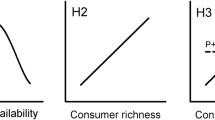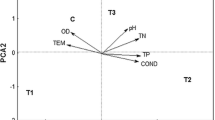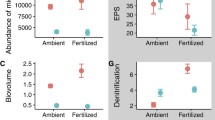Abstract
Ecological stoichiometry has been successful in enhancing our understanding of trophic interactions between consumer and prey species. Consumer and prey dynamics have been shown to depend on the nutrient composition of the prey relative to the nutrient demand of the consumer. Since most experiments on this topic used a single consumer species, little is known about the validity of stoichiometric constraints on trophic interactions across consumers and ecosystems. We conducted a quantitative meta-analysis on grazer–periphyton experiments to test (1) if benthic grazers have consistent effects on the nutrient composition of their prey, and (2) whether these effects can be aligned to the nutrient stoichiometry of grazer and periphyton, other environmental factors, or experimental constraints. Grazers significantly lowered periphyton C:N and C:P ratios, indicating higher N- and P-content of grazed periphyton across studies. Grazer presence on average increased periphyton N:P ratios, but across studies the effect size did not differ significantly from zero. The sign and strength of grazer effects on periphyton nutrient ratios was strongly dependent on the nutrient content of grazers and their food, but also on grazer biomass, the amount of biomass removal and water column nutrients. Grazer with low P-content tended to reduce periphyton P-content, whereas grazers with high P-content increased periphyton P-content. This result suggests that low grazer P-content can be an indication of physiological P-limitation rather than a result of having relatively low and fixed P-requirements. At the across-system scale of this meta-analysis, predictions from stoichiometric theory are corroborated, but the plasticity of the consumer nutrient composition has to be acknowledged.





Similar content being viewed by others
References
Ågren GI (2004) The C:N:P stoichiometry of autotrophs—theory and observations. Ecol Lett 7:185–191
Andersen T, Hessen DO (1991) Carbon, nitrogen and phosphorus content of freshwater zooplankton. Limnol Oceanogr 36:807–814
Anderson TR, Hessen DO, Elser JJ, Urabe J (2005) Metabolic stoichiometry and the fate of excess carbon and nutrients in consumers. Am Nat 165:1–15
Boersma M, Kreutzer C (2002) Life at the edge: is food quality really of minor importance at low quantities? Ecology 83:2552–2561
Bothwell ML (1989) Phosphorus-limited growth dynamics of lotic periphyton diatom communities: areal biomass and cellular growth rate response. Can J Fish Aquat Sci 46:1293–1301
Burkholder JM, Wetzel RG, Klomparens KL (1990) Direct comparison of phosphate uptake by adnate and loosely attached microalgae within an intact biofilm matrix. Appl Env Microbiol 56:2882–2890
Carline KA, Jones HE, Bardgett RD (2005) Large herbivores affect the stoichiometry of nutrients in a regenerating woodland ecosystem. Oikos 110:453–460
Cross WF, Benstead JP, Rosemond AD, Wallace JB (2003) Consumer-resource stoichiometry in detritus-based streams. Ecol Lett 6:721–732
Darchambeau F, Faerovig PJ, Hessen DO (2003) How Daphnia copes with excess carbon in its food. Oecologia 136:336–346
Darchambeau F, Thys I, Leporcq B, Hoffmann L, Descy JP (2005) Influence of zooplankton stoichiometry on nutrient sedimentation in a lake system. Limnol Oceanogr 50:905–913
Daufresne T, Loreau M (2001) Plant–herbivore interactions and ecological stoichiometry: when do herbivores determine plant nutrient limitation? Ecol Lett 4:196–206
DeMott WR, Gulati RD (1999) Phosphorus limitation in Daphnia: evidence from a long term study of three hypereutrophic Dutch lakes. Limnol Oceanogr 44:1557–1564
DeMott WR, Pape BJ (2005) Stoichiometry in an ecological context: testing for links between Daphnia P-content, growth rate and habitat preference. Oecologia 142:20–27
Elser JJ (2000) Ecological stoichiometry: from sea to lake to land. Trends Ecol Evol 15:393–394
Elser JJ, Urabe J (1999) The stoichiometry of consumer-driven nutrient recycling theory, observations, and consequences. Ecology 80:735–751
Elser JJ et al (2000a) Nutritional constraints in terrestrial and freshwater food webs. Nature 408:578–580
Elser JJ et al (2000b) Pelagic C:N:P stoichiometry in a eutrophied lake: responses to a whole-lake food-web manipulation. Ecosystems 3:293–307
Elser JJ et al (2003) Growth rate-stoichiometry couplings in diverse biota. Ecol Lett 6:936–943
Evans-White MA, Lamberti GA (2006) Stoichiometry of consumer-driven nutrient recycling across nutrient regimes in streams. Ecol Lett 9:1186–1197
Evans-White MA, Stelzer RS, Lamberti GA (2005) Taxonomic and regional patterns in benthic macroinvertebrate elemental composition in streams. Freshw Biol 50:1786–1799
Fagan WF, Denno RF (2004) Stoichiometry of actual vs. potential predator–prey interactions: insights into nitrogen limitation for arthropod predators. Ecol Lett 7:876–883
Fink P, Von Elert E (2006) Physiological responses to stoichiometric constraints: nutrient limitation and compensatory feeding in a freshwater snail. Oikos 115:484–494
Fink P, Peters L, von Elert E (2006) Stoichiometric mismatch between littoral invertebrates and their periphyton food. Arch Hydrobiol 165:145–165
Frost PC, Elser JJ (2002a) Effects of light and nutrients on the net accumulation and elemental composition of epilithon in boreal lakes. Freshw Biol 47:173–183
Frost PC, Elser JJ (2002b) Growth responses of littoral mayflies to the phosphorus content of their food. Ecol Lett 5:232–240
Frost PC, Elser JJ, Turner MA (2002a) Effects of caddisfly grazers on the elemental composition of epilithon in a boreal lake. J North Am Benthol Soc 21:54–63
Frost PC, Stelzer RS, Lamberti GA, Elser JJ (2002b) Ecological stoichiometry of trophic interactions in the benthos: understanding the role of C:N:P ratios in lentic and lotic habitats. J North Am Benthol Soc 21:515–528
Frost PC, Tank SE, Turner MA, Elser JJ (2003) Elemental composition of littoral invertebrates from oligotrophic and eutrophic Canadian lakes. J North Am Benthol Soc 22:51–62
Frost PC, Xenopoulos MA, Larson JH (2004) The stoichiometry of dissolved organic carbon, nitrogen, and phosphorus release by a planktonic grazer, Daphnia. Limnol Oceanogr 49:1802–1808
Frost PC, Evans-White MA, Finkel ZV, Jensen TC, Matzek V (2005a) Are you what you eat? Physiological constraints on organismal stoichiometry in an elementally imbalanced world. Oikos 109:18–28
Frost PC, Hillebrand H, Kahlert M (2005b) Low algal carbon content and its effect on the C:P stoichiometry of periphyton. Freshw Biol 50:1800–1807
Frost PC et al (2006) Threshold elemental ratios of carbon and phosphorus in aquatic consumers. Ecol Lett 9:774–779
Grover JP (2002) Stoichiometry, herbivory and competition for nutrients: simple models based on planktonic ecosystems. J Theor Biol 214:599–618
Grover JP (2003) The impact of variable stoichiometry on predator–prey interactions: a multinutrient approach. Am Nat 162:29–43
Hall SR (2004) Stoichiometrically explicit competition between grazers: species replacement, coexistence, and priority effects along resource supply gradients. Am Nat 164:157–172
Hall SR, Leibold MA, Lytle DA, Smith VH (2004) Stoichiometry and planktonic grazer composition over gradients of light, nutrients, and predation risk. Ecology 85:2291–2301
Hassett RP, Cardinale B, Stabler LB, Elser JJ (1997) Ecological stoichometry of N and P in pelagic ecosystems: comparison of lakes and oceans with emphasis on the zooplankton–phytoplankton interaction. Limnol Oceanogr 42:648–662
Hedges LV, Gurevitch J, Curtis PS (1999) The meta-analysis of response ratios in experimental ecology. Ecology 80:1150–1156
Hessen DO, Faerovig PJ, Andersen T (2002) Light, nutrients, and P:C ratios in algae: grazer performance related to food quality and quantity. Ecology 83:1886–1898
Hillebrand H (2008) Grazing regulates the spatial heterogeneity of periphyton. Ecology (in press)
Hillebrand H, Kahlert M (2001) Effect of grazing and nutrient supply on periphyton biomass and nutrient stoichiometry in habitats of different productivity. Limnol Oceanogr 46:1881–1898
Hillebrand H, de Montpellier G, Liess A (2004) Effects of macrograzers and light on periphyton stoichiometry. Oikos 106:93–104
Hillebrand H, Kahlert M, Haglund AL, Berninger UG, Nagel S, Wickham S (2002) Control of microbenthic communities by grazing and nutrient supply. Ecology 83:2205–2219
Hillebrand H, Sommer U (1999) The nutrient stoichiometry of benthic microalgal growth: redfield proportions are optimal. Limnol Oceanogr 44:440–446
Hunter RD (1980) Effects of grazing on the quantitiy and quality of freshwater Aufwuchs. Hydrobiologia 69:251–259
Jeyasingh PD, Weider LJ (2005) Phosphorus availability mediates plasticity in life-history traits and predator–prey interactions in Daphnia. Ecol Lett 8:1021–1028
Johnson JB, Omland KS (2004) Model selection in ecology and evolution. Trends Ecol Evol 19:101–108
Kahlert M, Baunsgaard MT (1999) Nutrient recycling—a strategy of a grazer community to overcome nutrient limitation. J North Am Benthol Soc 18:363–369
Kay AD, Scott SE, Schade JD, Hobbie SE (2004) Stoichiometric relations in an ant–treehopper mutualism. Ecol Lett 7:1024–1028
Klausmeier CA, Litchman E, Daufresne T, Levin SA (2004) Optimal nitrogen-to-phosphorus stoichiometry of phytoplankton. Nature 429:171–174
Liess A, Hillebrand H (2005) Stoichiometric variation in C:N, C:P, and N:P ratios of littoral benthic invertebrates. J North Am Benthol Soc 24:256–269
Liess A, Hillebrand H (2006) Role of nutrient supply in grazer–periphyton interactions: reciprocal influences of periphyton and grazer nutrient stoichiometry. J North Am Benthol Soc 25:632–642
Lodge DM (1986) Selective grazing on periphyton: a determinant of freshwater gastropod microdistributions. Freshw Biol 16:831–841
Logan JD, Joern A, Wolesensky W (2004) Control of CNP homeostasis in herbivore consumers through differential assimilation. Bull Math Biol 66:707–725
Loladze I, Kuang Y, Elser JJ, Fagan WF (2004) Competition and stoichiometry: coexistence of two predators on one prey. Theor Popul Biol 65:1–15
McCormick PV, Stevenson RJ (1991) Grazer control of nutrient availability in the periphyton. Oecologia 86:287–291
Mulholland PJ, Steinman AD, Palumbo AV, Elwood JW, Kirschtel DB (1991) Role of nutrient cycling and herbivory in regulating periphyton communities in laboratory streams. Ecology 72:966–982
Paterson MJ, Findlay DL, Salki AG, Hendzel LL, Hesslein RH (2002) The effects of Daphnia on nutrient stoichiometry and filamentous cyanobacteria: a mesocosm experiment in a eutrophic lake. Freshw Biol 47:1217–1233
Quigg A et al (2003) The evolutionary inheritance of elemental stoichiometry in marine phytoplankton. Nature 425:291–294
Quinn GP, Keough MJ (2002) Experimental design and data analysis for biologists. Cambridge University Press, Cambridge
Riber HH, Wetzel RG (1987) Boundary-layer and internal diffusion effects on phosphorus fluxes in lake periphyton. Limnol Oceanogr 32:1181–1194
Rosenberg MS, Adams DC, Gurevitch J (2000) MetaWin Version 2.0 statistical software for meta-analysis. Sinauer Associates, Sunderland
Sommer F, Santer B, Jamieson C, Hansen T, Sommer U (2003) Daphnia population growth but not moulting is a substantial phosphorus drain for phytoplankton. Freshw Biol 48:67–74
Steinman AD, Mulholland PJ, Kirschtel DB (1991) Interactive effects of nutrient reduction and herbivory on biomass, taxonomic structure, and P uptake in lotic periphyton communities. Can J Fish Aquat Sci 48:1951–1959
Steinman AD, Mulholland PJ, Hill WR (1992) Functional responses associated with growth forms in stream algae. J North Am Benthol Soc 11:229–243
Stelzer RS, Lamberti GA (2001) Effects of N:P ratio and total nutrient concentration on stream periphyton community, biomass, and elemental composition. Limnol Oceanogr 46:356–367
Stelzer RS, Lamberti GA (2002) Ecological stoichiometry in running waters: periphyton chemical composition and snail growth. Ecology 83:1039–1051
Sterner RW (1990) The ratio of nitrogen to phosphorus resupplied by herbivores: zooplankton and the algal competitive arena. Am Nat 136:209–229
Sterner RW, Elser JJ (2002) Ecological stoichiometry. Princeton University Press, Princeton
Sterner RW, Hessen DO (1994) Algal nutrient limitation and the nutrition of aquatic herbivores. Annu Rev Ecol Syst 25:1–29
Urabe J, Kyle M, Makino W, Yoshida T, Andersen T, Elser JJ (2002) Reduced light increases herbivore production due to stoichiometric effects of light/nutrient balance. Ecology 83:619–627
Vanni MJ, Flecker AS, Hood JM, Headworth JL (2002) Stoichiometry of nutrient recycling by vertebrates in a tropical stream: linking species identity and ecosystem processes. Ecol Lett 5:285–293
Villar-Argaiz M, Medina-Sanchez JM, Carrillo P (2002) Linking life history strategies and ontogeny in crustacean zooplankton: Implications for homeostasis. Ecology 83:1899–1914
Vrede K, Heldal M, Norland S, Bratbak G (2002) Elemental composition (C, N, P) and cell volume of exponentially growing and nutrient-limited bacterioplankton. Appl Environ Microbiol 68:2965–2971
Vrede T, Dobberfuhl DR, Kooijman SALM, Elser JJ (2004) Fundamental connections among organism C:N:P stoichiometry, macromolecular composition, and growth. Ecology 85:1217–1229
Acknowledgments
This analysis depended on a large grazer–periphyton database developed with funding resources from the Erken Laboratory, University of Uppsala (S) and the IfM-GEOMAR at the University of Kiel (D). This particular analysis was conducted with funding from the German research council (DFG, project Hi 848/4-1) to Helmut Hillebrand. We thank Rotbert Ptacnik, Patrick Fink and two anonymous reviewers for insightful comments on this analysis. We declare that this analysis complies with the current law of our home countries.
Author information
Authors and Affiliations
Corresponding author
Additional information
Communicated by Ulrich Sommer.
Electronic supplementary material
Rights and permissions
About this article
Cite this article
Hillebrand, H., Frost, P. & Liess, A. Ecological stoichiometry of indirect grazer effects on periphyton nutrient content. Oecologia 155, 619–630 (2008). https://doi.org/10.1007/s00442-007-0930-9
Received:
Accepted:
Published:
Issue Date:
DOI: https://doi.org/10.1007/s00442-007-0930-9




